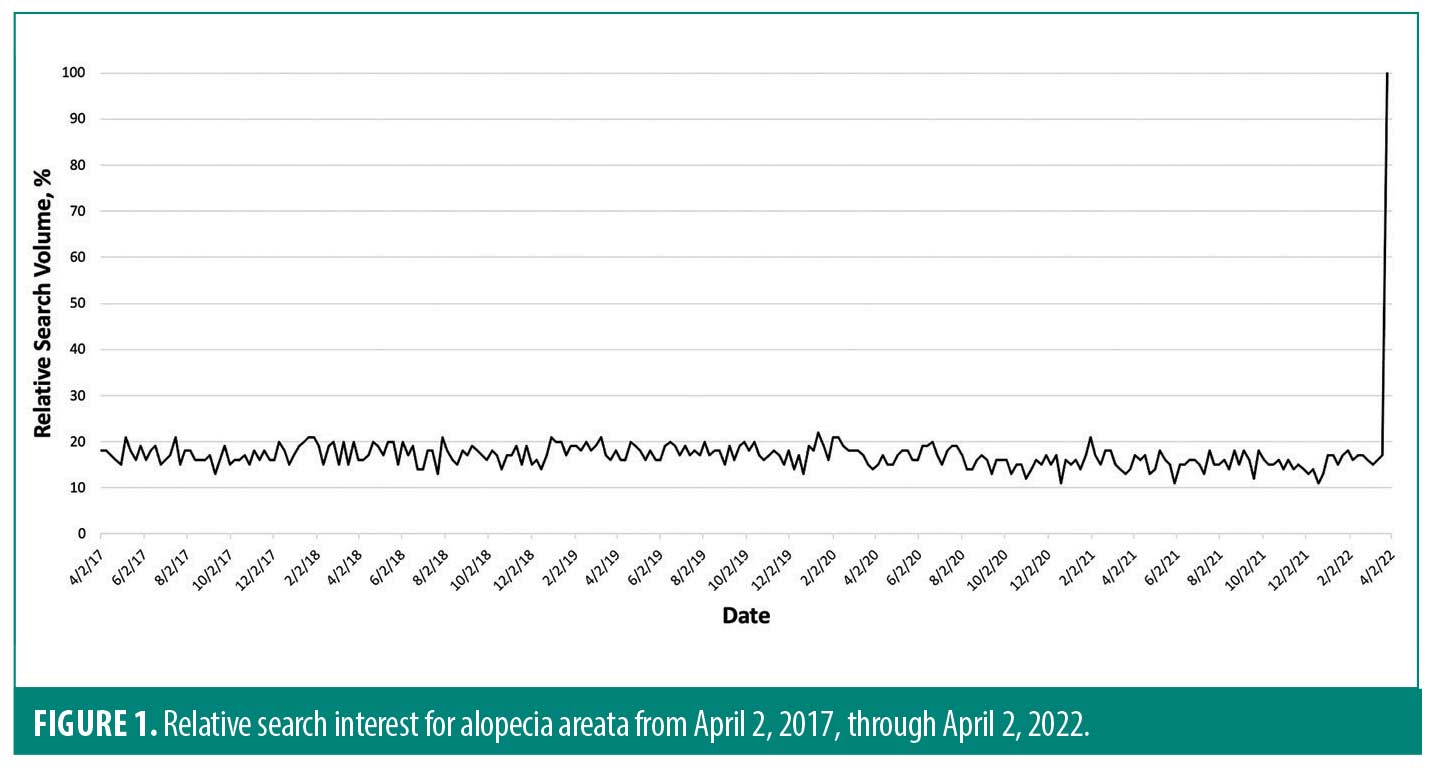 J Clin Aesthet Dermatol. 2022;15(12):40–41.
J Clin Aesthet Dermatol. 2022;15(12):40–41.
by Christian X. Lava, MS, and Amir A. Hakimi, MD
Mr. Lava is with Georgetown University School of Medicine in Washington D.C. Dr. Hakimi is with the Department of Otolaryngology–Head and Neck Surgery at Medstar Georgetown University Hospital in Washington, D.C.
FUNDING: Funding for this study was provided by The Ohio State University Medical Student Research Scholarship.
DISCLOSURES: The authors report no conflicts of interest relevant to the content of this article.
Alopecia areata (AA) affects approximately 6.8 million people in the United States, and approximately 147 million people in the world have or will develop AA at some point in their lives.1 The disorder’s unpredictable course and absence of preventative therapy may precipitate anxiety and depression among individuals with AA.2 Increasing public awareness of this condition and its associated psychosocial burdens may help reduce stigma and discrimination, and in turn promote self- and social acceptance among individuals suffering from with the disease.
AA was magnified to an international audience at the 94th Academy Awards after comedian Chris Rock joked about the shaved head of Jada Pinkett Smith, who has AA. Subsequently, actor Will Smith walked onto the stage and struck Rock on live television. This incident has since garnered worldwide attention to not only the assault, but also to AA. In this study, we used Google Trends (Google LLC, Mountain View, California) to investigate the association of this dramatic event with public interest and awareness of AA.
Methods
Google Trends is an online tool that has become increasingly popular in healthcare research to demonstrate how often a search term is entered relative to the total search volume over time. This tool provides a relative search volume (RSV), which is the number of searches for a term standardized to the total number of searches over a particular time period. We reviewed the search term “alopecia areata” using this tool between April 2, 2017, and April 2, 2022. Special attention was drawn to the RSV following the 94th Academy Awards, which took place on March 27th, 2022. Rising searches, defined as terms that were searched for with the keyword “alopecia areata,” which had the most significant growth in volume during a period of interest, were also assessed over the year preceding the 94th Academy Awards.
Results
The week of March 27 to April 2, 2022, demonstrated the greatest peak in interest, with 100 RSV over the five-year period; this corresponds with the 94th Academy Awards (Figure 1). Queries that included “Will Smith”, “Chris Rock”, and “GI Jane” were among the top rising searches associated with “alopecia areata;” we noted a 5,000-percent search growth compared to the preceding year. The top 10 rising searches are detailed in Table 1; 50 percent of these terms are associated with the Academy Awards.


Discussion
The televised dispute between Will Smith and Chris Rock at the 94th Academy Awards may have triggered public interest in the search term “alopecia areata”. Importantly, this event demonstrates the stigma that may arise among patients with AA. Creadore et al3 found that people often stigmatize individuals with AA, and that their stigma increases with severity and is influenced by sex and race. Specifically, laypersons more frequently described patients with severe AA as “sick”, “not attractive”, “contagious”, and “unintelligent” compared to those with mild to moderate AA. The magnitude of this stigma was most evident in Black male patients.3 Rock’s joke was perceived by many as insensitive. However, the increased public awareness of AA, evidenced by the increase in Google searches following the Academy Awards, can be interpreted as a positive result of the events at the awards show.
The media plays a critical role in shaping public opinion and interest regarding medical conditions.4 These data speak to the media’s influence to raise public awareness of disorders like AA and their associated psychosocial burdens.
References
- Benigno M, Anastassopoulos KP, Mostaghimi A, et al. A Large Cross-Sectional Survey Study of the Prevalence of Alopecia Areata in the United States. Clin Cosmet Investig Dermatol. 2020 Apr 1;13:259–266.
- Sterkens A, Lambert J, Bervoets A. Alopecia areata: a review on diagnosis, immunological etiopathogenesis and treatment options. Clin Exp Med. 2021 May;21(2):215–230.
- Creadore A, Manjaly P, Li SJ, et al. Evaluation of Stigma Toward Individuals With Alopecia. JAMA Dermatol. 2021 Apr 1;157(4):392–398.
- Hakimi AA, Lava CX, Parsa KM, et al. The Association of Treacher Collins Syndrome in the Media with Public Interest. Facial Plast Surg. 2022. Online ahead of print.
- Google Trends Help. Find Related Searches. Available from: https://support.google.com/trends/answer/4355000?hl=en. Accessed April 2, 2022.

